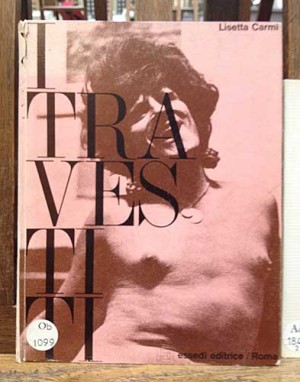Lisetta Carmi’s I Travestiti (Essedi Editions, 1972) is a disquieting book, and at times, looking at it feels like staring a little too long. Carmi’s images grant visual access to a marginalized group living on a rough fringe of 1970s Genoa society. The book succeeds in conveying the turbulent lives of these women as they pursue identity.
Carmi photographs in various modes, from constructed portraits to on-the-street-scenes. Overall, the images possess a tough naturalism that spares no spot, line, or wrinkle. This naturalism creates an unsettling contrast between the over-the-top glamour attempted by many of the women and the bleak reality of their circumstances.
The push and pull between fantasy and reality is often heartbreaking; in these images, the hope, energy, and sacrifice made by these women to build themselves and their lives rarely seem to yield freedom or happiness. There is an image in the series that depicts a moment of bliss; it is of a male attendant being embraced by two of the women at a houseparty. Carmi placed such importance on this image that it appears twice, first in full and then in detail. This emphasis implies that happiness and satisfaction reside in an audience.
Parr and Badger note that, “the book is both sociologically and photographically interesting, an eloquent plea, made by a real woman, for society to understand these ‘other’ women, trapped inside the wrong bodies (Volume I, p. 228).” The most eloquent pleas in this regard are made by the women themselves in the first signature of the book. These diaristic pages establish an intimate tone for the book by pairing close-up portraits of the women with type-written texts about their lives.
Above, the subject writes, “It may sound strange to you, but I don’t feel like a transvestite, I feel like a woman. . . . I am not a narcissist because I don’t look up to my beauty. I have my manners, my own gait, my behavior, my way of expressing myself, of talking, of living: my only distraction is that my nature is different than the one I should have.” (Sorry non-Italian speakers, all texts in I Travestiti are in Italian.)
About half-way through the book, there is a “centerfold” that shows the extraordinary cover image in full, which is a relief because the image is so obscured on the cover, with text and image fighting each other. Carmi’s portrait of her topless subject is strong and lovely, and it does a wonderful job of insinuating the gritty yet sympathetic portrayal of her subjects found throughout the book, as well as the trust and friendship that she shared with them.
The specific shade of pink featured both in the first signature and on the cover makes powerful and important use of color. This is a pink that references pancake makeup rather than a rosebud. It’s a color that perfectly encapsulates both the beauty and the artifice considered in I Travestiti. —Mary Goodwin
I looked at a copy of I Travestiti at the National Library of France, Richelieu, Paris. You’re in luck if you live in or are visiting Amsterdam, where there are copies of this book in three separate public institutions. You can click here to search for a copy of I Travestiti near you. Otherwise, getting a hold of a copy of this book may prove difficult.




